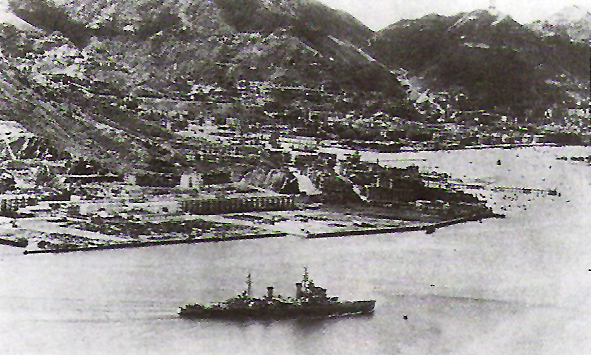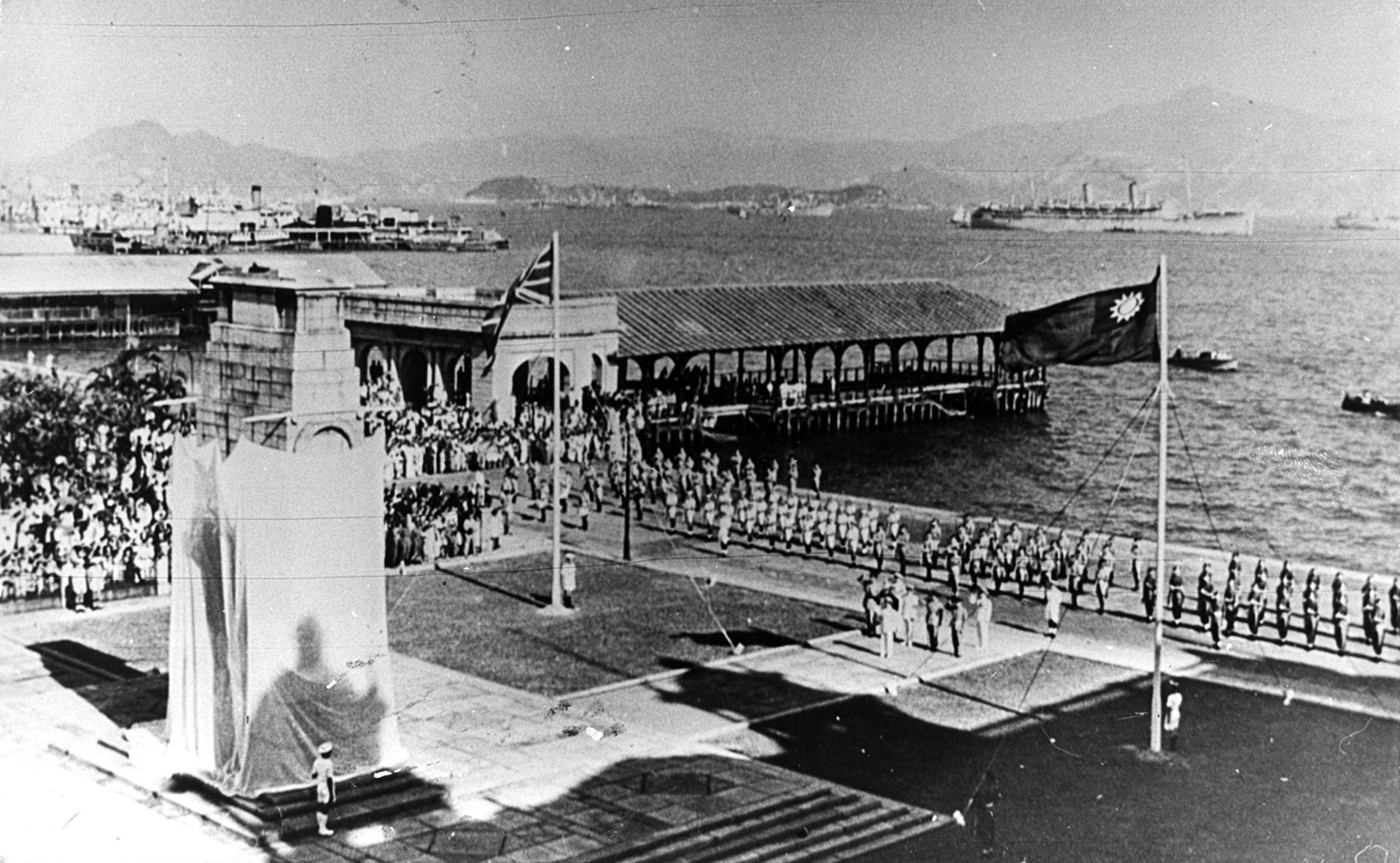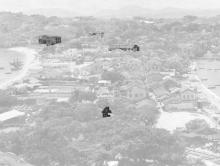"The Empire Strikes Back"
Primary tabs
Noctes atque dies patet atri ianua Ditis;
Sed revocare gradum superasque evadere ad auras,
Hos opus, hic labor est.
It is easy to descend into Hell;
Day and night, the gates of Dis stand open;
But to climb out, and to regain the heavens,
That's work, that's a real struggle.
(Virgil, Aeneid, my translation)
Japan surrendered on the 15th of August 1945; there were no Allied naval forces near Hong Kong but a Royal Navy squadron was despatched to Hong Kong post haste. It arrived on the 30th - 19 ships, seven of which were Australian, complete with Admiral Harcourt, the battleship Anson and the aircraft carrier Inflexible.
For the previous fortnight the situation had been a bit uncertain - the Governor, Sir Mark Young, had been interned by the Japanese in Manchuria and the Colonial Secretary, Sir Franklin Gimson, (who had had the misfortune to arrive in Hong Kong to take up his post one week before the Japanese invasion!) proclaimed himself Acting Governor whilst still in Stanley internment camp, on instructions from the British Ambassador in Chungking, who knew that the Nationalist Government were expecting that the place was about to be given to them by the Americans.
The Taipan of the Great and Ancient Hong walked out of the gates of Stanley camp and found that his company's business empire was intact; the Compradore, who as a Chinese citizen had not been interned, had paid salaries out of his own pocket, ruining himself in the process, to keep things going, as well as bribing the camp guards to get food parcels in to his colleagues.

"The Empire Strikes Back" - the cruiser HMS Swiftsure enters a bomb damaged Hong Kong, 30th August 1945 with Admiral Harcourt aboard - she is off North Point so she has has just passed taikoo Docks, the location of the previous photograph...

We are looking at the Cenotaph, in 1945. I have, after a bit of homework, put a date to this picture. It's the 9th October 1945, and we are seeing a combined celebration of Victory and Chinese National Day. New carving on the Cenotaph, adding the words "1939-45" to the original insceription, which simply read "The Glorious Dead", is about to be unveiled.
(The Chinese text on the Cenotaph reads "May their martyred souls be immortal, and their noble spirits endure" and it was added in the Sixties. The Cenotaph itself is identical to the one in London, which I think makes it unique. It is now (2009) a scheduled ancient monument, but ceremonies are no longer held there.)
This picture was probably taken from the balcony of the old Hong Kong Club. Rea-Admiral Harcourt is taking the salute.
Note the two flagstaffs, both temporary, and erected for the event. We see the Chinese Nationalist flag, flying alongside the Union Flag. Such a sight would be unthinkable at any time after 1949, but in 1945 Britain was seriously considering handing Hong Kong back to China and talks about this were starting between the British and the Chinese Governments.
The Band of the Royal Marines have just played both National Anthems and the modern battleship HMS Anson is about to fire a seventeen gun salute. also present are Major-General Pan of the KMT, Admiral Buckmaster of the USN and Lady Mountbatten.
The structure in the middle distance is the old Queen's Pier; the harbour is a good deal further away, now.
The provisional administration of Hong Kong was carried out by the miltary with assistance from officers of the BAAG, who were in an unusually good position to know what was wanted.
Hong Kong bounced back from wartime conditions with lightning speed - rationing was ended in November 1945, six years ahead of Britain. People deported to China moved back and by February 1946 the population was over a million once more.
Something must have happened to Mark Young (who was reinstated as Governor) and to Franklin Gimson, during their time in captivity, because they both, independently, recommended a democratic franchise for the Legislative Council - Sir Mark went so far as to specify that a majority vote in Legco could not be overturned by the Governor's veto.


Comments
Liberation
The fleet that enterred Hong Kong harbour was led by Admiral Bruce Fraser on HMS Duke of York,on his way to Tokyo to participate in Japan's official surrender to General MacAuther. Harcourt remained behind with HMS Anson to assist with the take-over. There were numerous aircraft carriers - Indomidable, Vengeance, Ocean, Venerable, Indefatigable (I think). Sistership to HMS Swiftsure was the Canadian cruiser the Ontario. Of course, preceding this armada were the minesweepers. There were about 4 to 6 submarines tied alongside at Tamar, with the submarine tender, also alongside, HMS Maidstone. Those were heady days.
Re: Liberation
Thanks Bob, yesterday I was reading Barbara Anslow's notes from the time between the Japanese surrender and the arrival of the British fleet. She wrote:
We look out to sea and cry "Come on Nimitz, or Fraser - we've been waiting for you for years - now you can come, what's all the delay?"
I wondered who Fraser was, and now I know!
Regards, David
Reoccupation 1945
Bob is right in principle but a bit awry on the detail. In fact Anson was the first battleship to arrive. She had been tasked to go to Singapore with the Vengeance, but there were problems so both ships were redirected to HK and got here a few days after the first units arrived of the Lemas on 29 August. The first ships entered HK the next day.
There's a well known photo of Anson anchored in Kowloon Bay. The Duke of York arrived c.15.9.1945 in time for Admiral Fraser to attend the Japanese surrender in Government House (he did not preside over it, that was Admiral Harcourt who'd by this time become C-in-C HK).
There is an almost ship-by-ship account from the reproduced war diary of Bruice Fraser's command at the utterly wonderful http://www.naval-history.net/xDKWD-BPF4512OccupationofChinaCoast1945.htm (cannot recommend the site too strongly for WW2 naval war buffs).
The ships that entered on 30.8 were HMS SWIFTSURE (cruiser - flying flag of Rear Admiral Harcourt, who'd transferred it from Indomitable on 29.8), HMS EURYALUS (light cruiser), HMCS PRINCE ROBERT (armoured cruiser), HM Ships KEMPENFELT, URSA, WHIRLWIND, QUADRANT (destroyers). These were swiftly followed by the hospital ship OXFORDSHIRE.
ANSON (battleship), VENGEANCE, INDOMITABLE, VENERABLE (carriers) stayed outside until the Royal Australian Navy Minesweeping Squadron (HMAShips Bathurst, Wagga, Fremantle, Mildura, Geraldton, Castlemaine, Strahan and Broome) had cleared safe passage.
Interestingly the first ship into HK was therefore not a British ship but HMAS Mildura, which was first through Lei Yue Mun but then had to pull over to let first Kempenfelt and then the Admiral in Swiftsure past. Swiftsure was preceded in by Kempenfelt because less expensive if someone had missed a mine.
The sweepers also provided the first ship to go to Stanley to help the internees and the first ship to go to Macao.
By sometime around mid-September there were over 40 naval ships in the harbour including the accommodation ship HMS Aorangi (a famous pre- and post-war liner of the NZ Union Steamship Co.), which I think can be seen over the top of the Cenotaph in Andrew's photo.
Stephen D